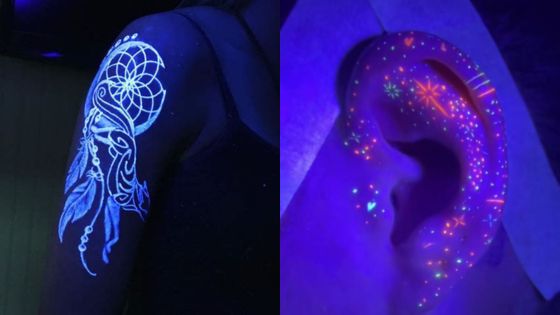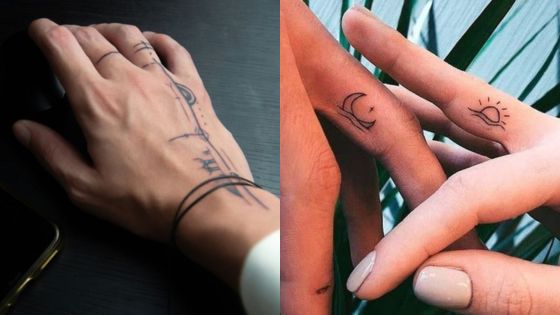Phoenix tattoos are popular choices for body art. They symbolize rebirth, renewal, and transformation. Many people find meaning in these powerful images.
There are many creative ways to design a phoenix tattoo. Some opt for colorful, realistic depictions while others prefer stylized or minimalist versions. The placement and size can also vary widely depending on personal preference.
1) Geometric Phoenix
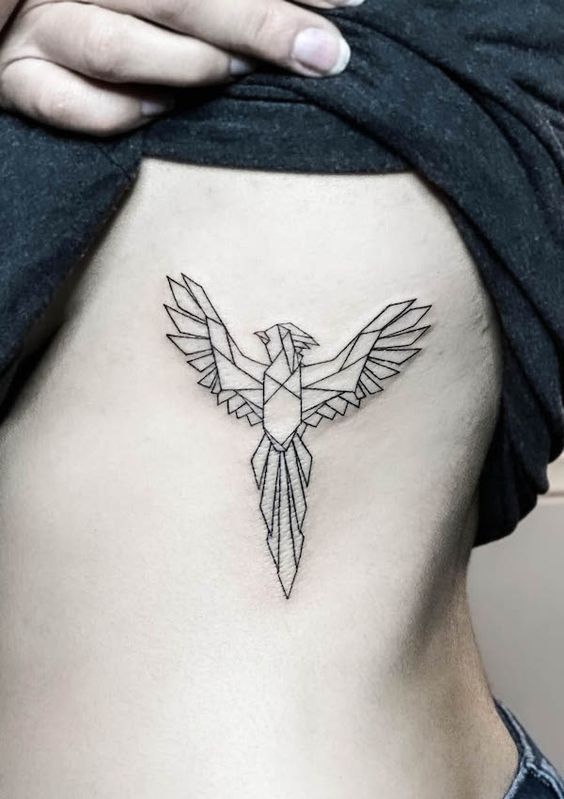
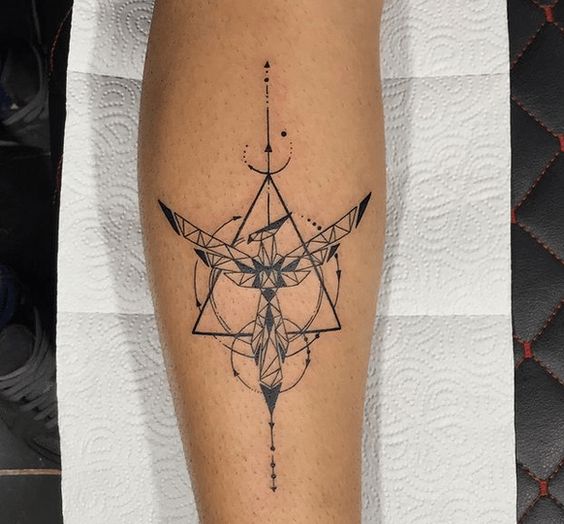
Geometric phoenix tattoos blend angular shapes with the mythical bird’s form. These designs use lines, triangles, and other geometric elements to create a stylized phoenix.
Artists often incorporate circles, squares, and polygons to form the bird’s body and wings. The result is a modern, abstract take on the traditional phoenix image.
Some geometric phoenix tattoos feature clean, precise lines. Others mix straight edges with curves for a more organic feel. The level of detail can range from simple outlines to complex patterns.
Color choices for geometric phoenix tattoos vary. Some people opt for bold, vibrant hues like red and orange. Others prefer a more subtle approach with black ink or grayscale shading.
Placement for these tattoos is flexible. They can work well on larger areas like the back or chest. Smaller designs might fit on the forearm or ankle.
Geometric phoenix tattoos can symbolize rebirth and transformation. The structured design elements add a sense of order and balance to the phoenix’s fiery nature.
Looking for even more tattoo inspo before you settle on a design? Check out our tattoo trends guide for ideas that go beyond mythic motifs.
2) Watercolor Phoenix
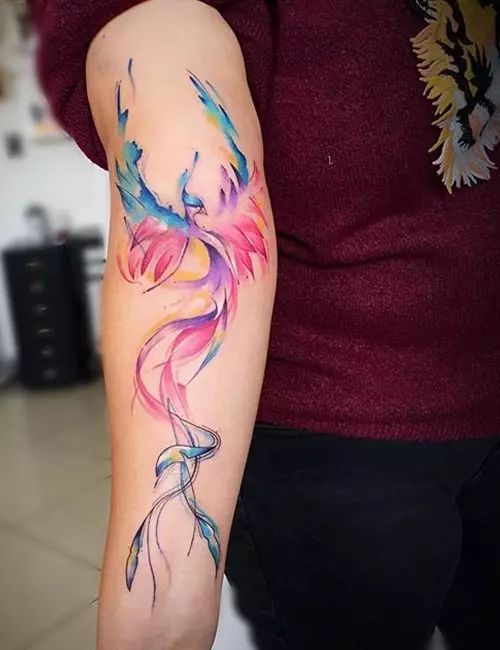
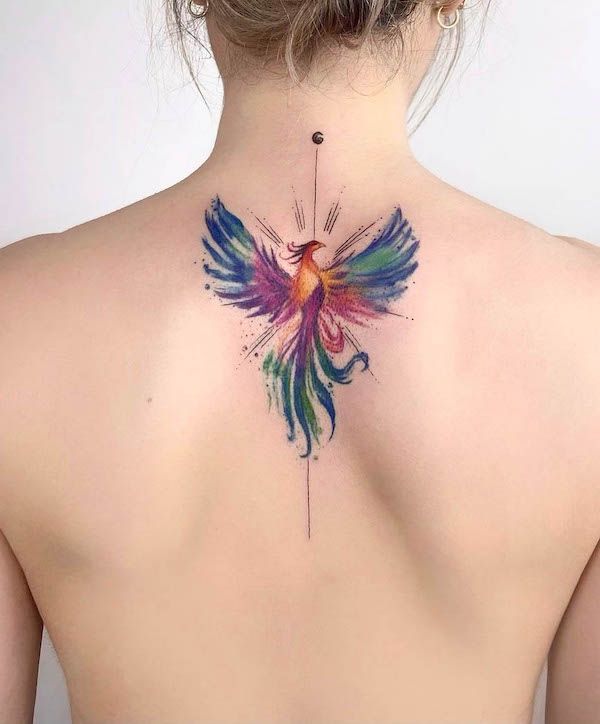
Watercolor phoenix tattoos blend vibrant colors and soft edges to create a striking effect. These designs feature fluid lines and color gradients that mimic the look of watercolor paintings on skin.
Artists use shades of red, orange, and yellow to capture the fiery nature of the phoenix. Blues and purples are often added to create depth and contrast. The result is a tattoo that appears to glow from within.
Watercolor techniques allow for creative interpretations of the phoenix. Some designs focus on the bird’s head and wings, while others depict the full body in flight. The lack of defined outlines gives these tattoos a dreamy, ethereal quality.
Many people choose watercolor phoenix tattoos for their symbolic meaning. The phoenix represents rebirth and renewal. The flowing colors can symbolize transformation and change.
Watercolor tattoos require a skilled artist to execute properly. The ink may fade faster than traditional tattoos, so touch-ups might be needed over time. Placement is important, as areas with less sun exposure tend to maintain color better.
3) Minimalist Phoenix Outline
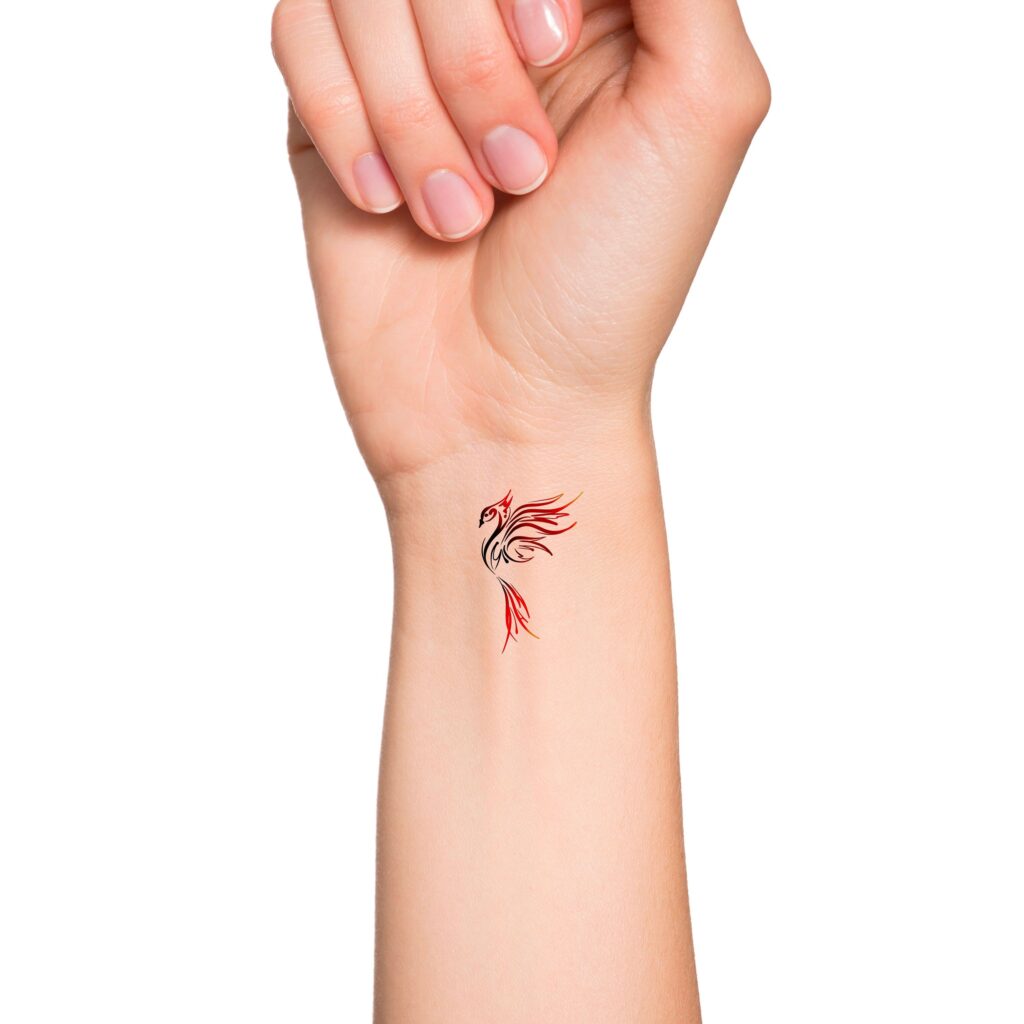
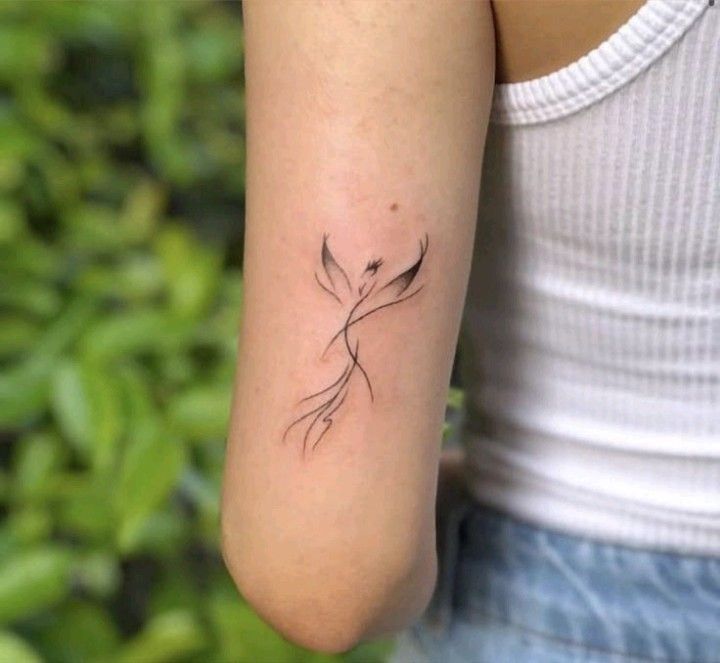
A minimalist phoenix outline tattoo is a popular choice for those who prefer simple designs. This style uses clean lines to create a basic shape of the mythical bird. The tattoo often features just the outline, with no shading or color.
Minimalist phoenix outlines can be small and discreet or larger and more eye-catching. They work well on various body parts, including wrists, ankles, or behind the ear. Some people choose to place them on their back or chest for a bolder statement.
These tattoos often show the phoenix with its wings spread wide. The design may include a few key details like the bird’s head, beak, and tail feathers. Some artists add small flame elements to represent the phoenix’s rebirth from ashes.
The simplicity of a minimalist phoenix outline allows for personal interpretation. It can symbolize resilience, renewal, or transformation without being too complex. This style appeals to those who want a meaningful tattoo that’s not overly flashy.
4) Tribal Phoenix
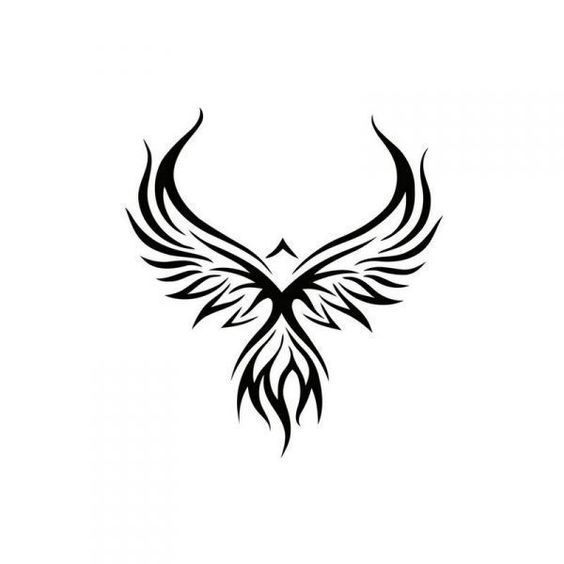
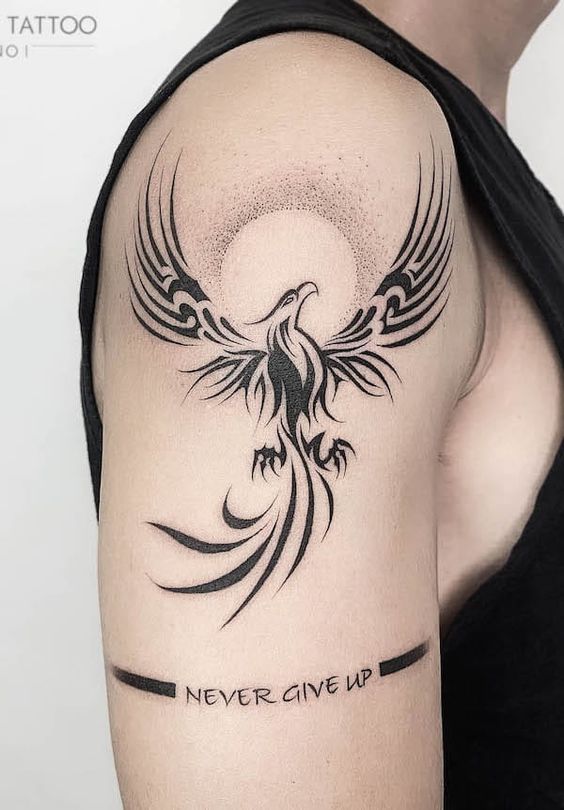
Tribal phoenix tattoos blend ancient symbolism with bold, geometric designs. These tattoos often feature sharp lines and angular shapes that form the body and wings of the phoenix.
Many tribal phoenix designs draw inspiration from Polynesian, Maori, or Celtic art styles. The result is a striking, stylized bird that catches the eye with its strong silhouette.
Black ink is commonly used for tribal phoenix tattoos. This creates a high-contrast look that stands out against the skin. Some designs incorporate red or orange accents to represent fire.
Tribal phoenix tattoos can be placed on various body parts. Popular spots include the upper arm, back, chest, and calf. The size of the tattoo can range from small and compact to large and sprawling.
These tattoos often symbolize strength, rebirth, and transformation. The tribal style adds an element of cultural significance and timeless appeal to the phoenix motif.
5) Phoenix with Flame Details
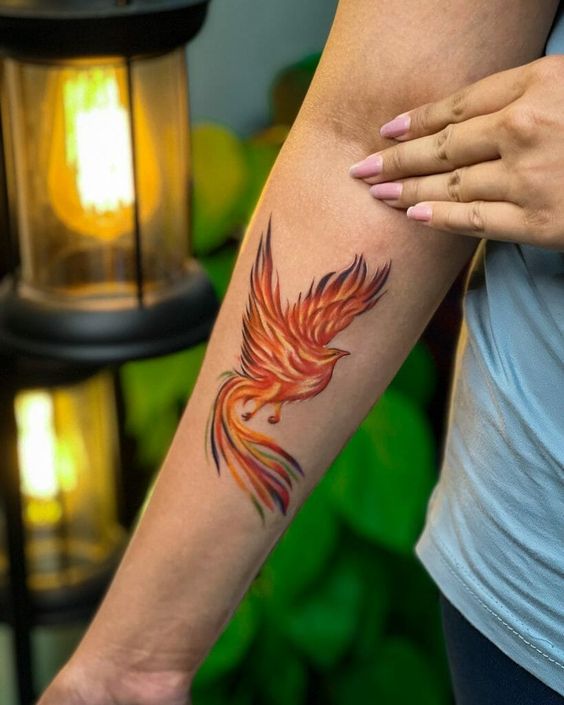
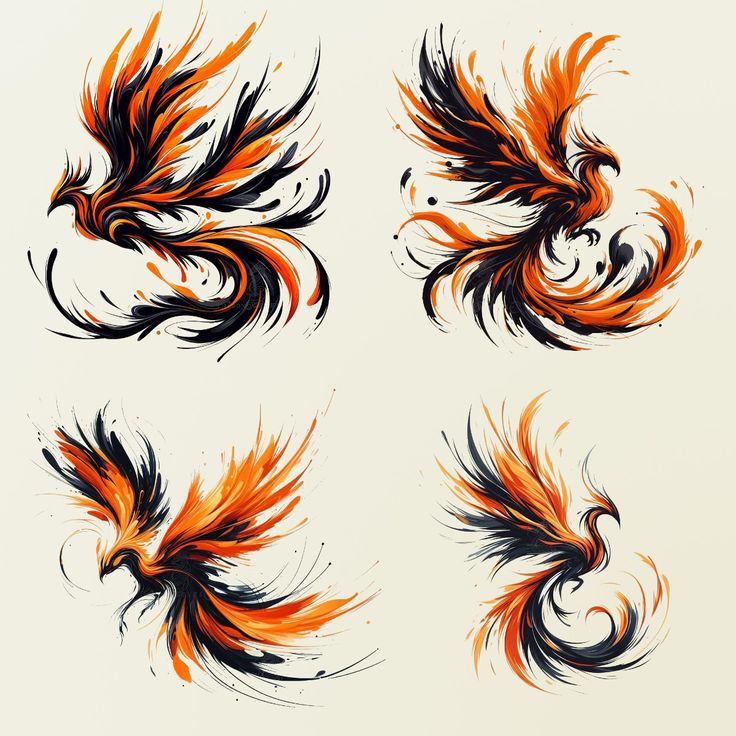
Phoenix tattoos with flame details add extra flair to the mythical bird design. These tattoos often show the phoenix surrounded by or emerging from vibrant flames. The fire element enhances the symbolism of rebirth and renewal.
Artists use various techniques to create realistic flame effects. They might blend warm colors like red, orange, and yellow to mimic flickering fire. Some designs feature intricate flame patterns that swirl around the phoenix’s body.
The flames can be subtle or bold depending on personal preference. Subtle designs may have small licks of fire at the phoenix’s wingtips or tail feathers. Bolder tattoos might depict the entire bird engulfed in a fiery blaze.
The design often includes flames or ashes. This highlights the cycle of death and rebirth. Color choices can add meaning too. Red phoenixes may symbolize passion, while blue ones could represent calm and healing.
For deeper insight into the spiritual meaning behind your phoenix tattoo and how it relates to your life path, you can always ask psychic on Nebula. Their skilled, dedicated guidance can help reveal the personal transformation your phoenix symbol may reflect.
Phoenix with flame tattoos work well in different styles. Traditional designs often use solid colors and bold outlines. Realistic styles aim to capture lifelike fire textures and shading.
These tattoos can be placed on various body parts. Larger designs suit areas like the back or chest. Smaller flame details can be added to phoenix tattoos on arms or legs.
6) Realistic Phoenix
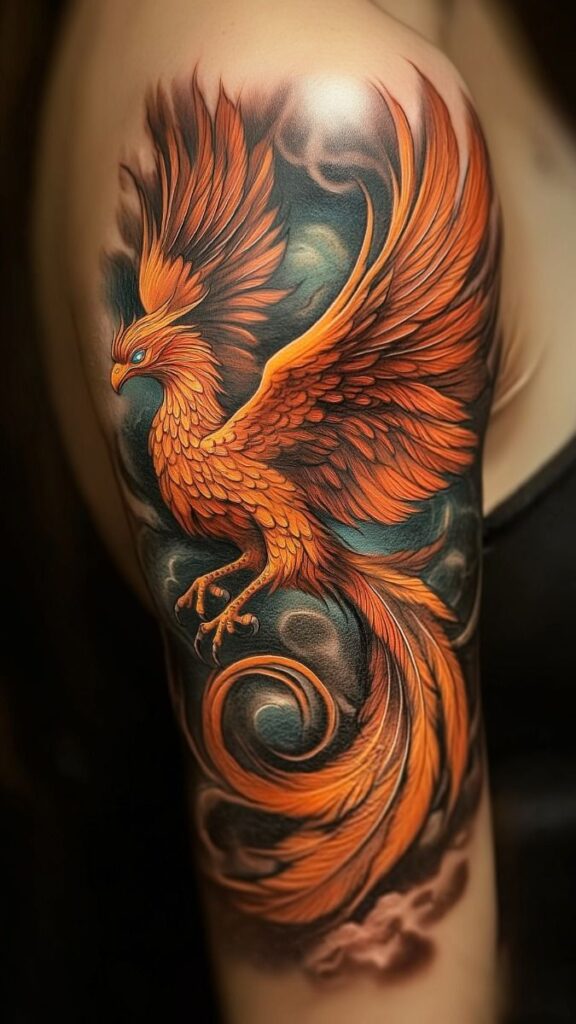
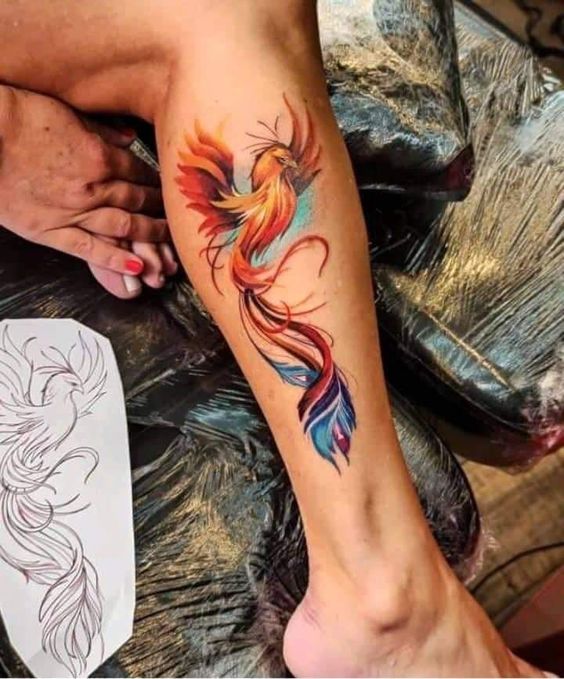
Realistic phoenix tattoos aim to capture the bird’s lifelike appearance. These designs show the phoenix in vivid detail, from its feathers to its eyes.
Artists use shading and color blending to create a 3D effect. This makes the tattoo look almost like a photograph on the skin.
Realistic phoenixes often have dramatic poses. They might be rising from flames or spreading their wings in flight.
The colors in these tattoos tend to be rich and vibrant. Reds, oranges, and golds are common choices. Some artists add blue or purple accents for contrast.
Placement is key for realistic phoenix tattoos. Larger areas like the back or chest allow for more detail. This gives the artist space to show off their skills.
These tattoos can take several sessions to complete. The time allows for careful attention to each feather and flame.
7) Japanese Style Phoenix
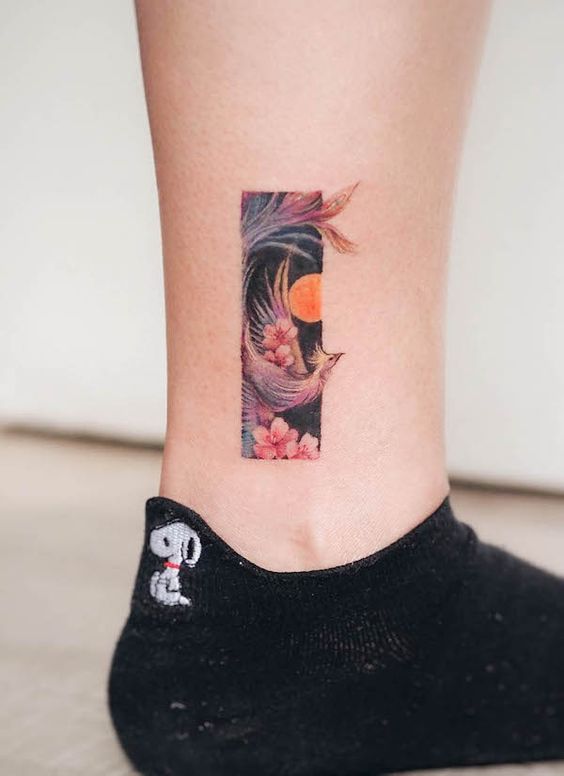
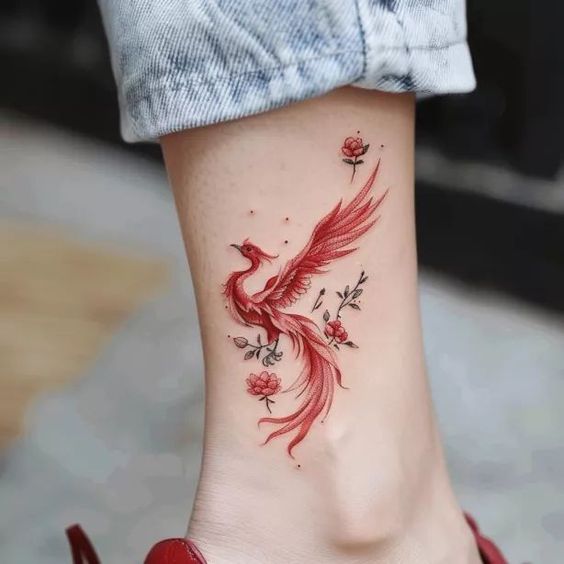
Japanese style phoenix tattoos blend traditional artistic elements with mythological symbolism. These designs often feature vibrant colors and intricate details characteristic of Japanese art.
The phoenix, known as “ho-oh” in Japanese, is depicted with a long, elegant neck and flowing tail feathers. Its plumage typically includes shades of red, orange, and gold, symbolizing fire and rebirth.
In Japanese tattoo art, the phoenix is often surrounded by other traditional motifs. These may include cherry blossoms, clouds, or waves, enhancing the overall composition.
The size of Japanese style phoenix tattoos can vary. Some people choose large designs covering their back or chest, while others opt for smaller pieces on arms or legs.
Artists skilled in Japanese tattooing techniques, called “irezumi,” are best suited to create these complex designs. They use specialized tools and techniques to achieve the distinctive look of Japanese-style tattoos.
8) Abstract Phoenix
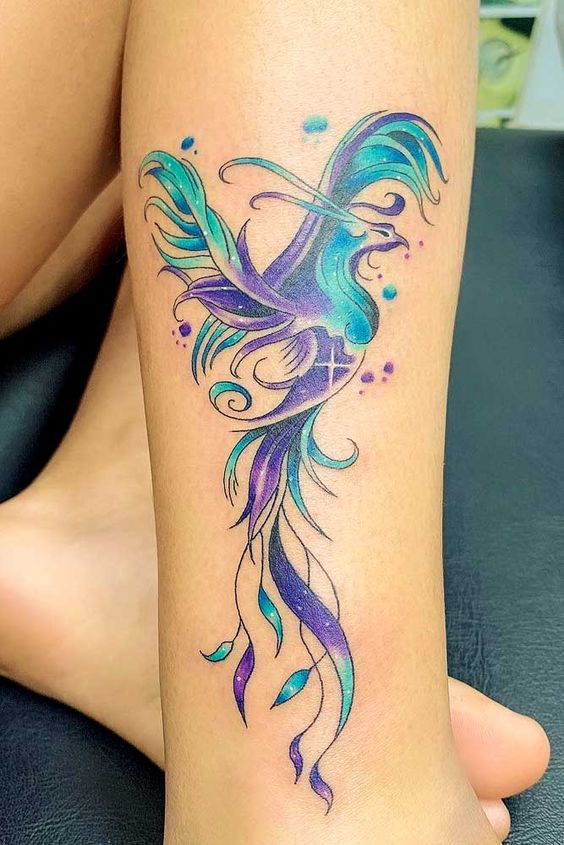
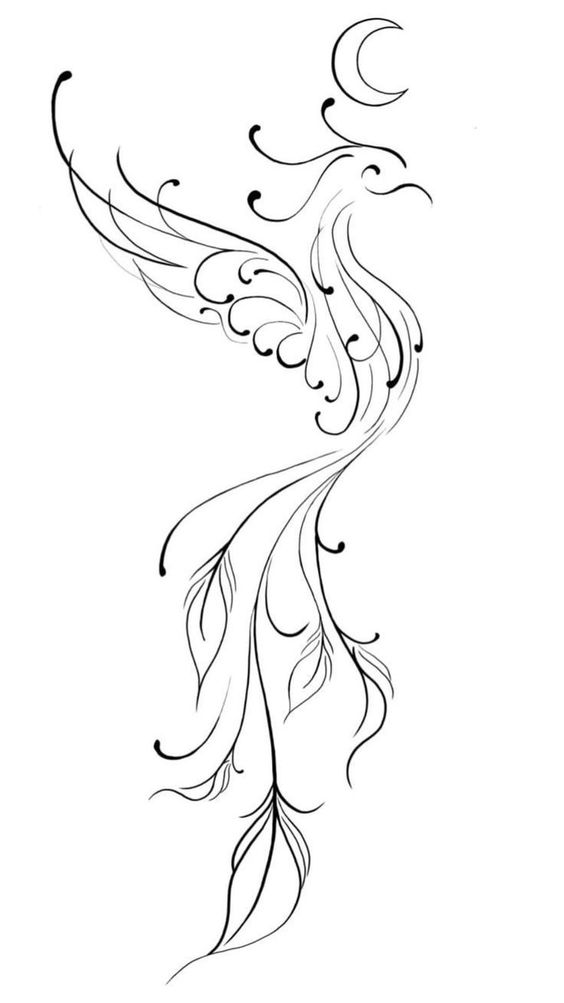
Abstract phoenix tattoos offer a unique twist on the classic design. These tattoos use simplified shapes and lines to create a stylized bird. They often feature bold, geometric patterns instead of realistic feathers.
Artists may use bright colors or stick to black ink for a striking look. Some abstract phoenix designs incorporate swirling lines to suggest movement and rebirth. Others use angular shapes for a more modern feel.
Abstract phoenixes can be small and subtle or large and eye-catching. They work well on various body parts, from wrists to backs. Some people choose to add meaningful symbols or words to their abstract phoenix tattoo.
This style allows for creative interpretation of the phoenix myth. It can represent personal growth, transformation, or overcoming challenges in a visually interesting way. Abstract designs often appeal to those who prefer a more artistic or minimalist aesthetic.
9) Phoenix with Floral Elements
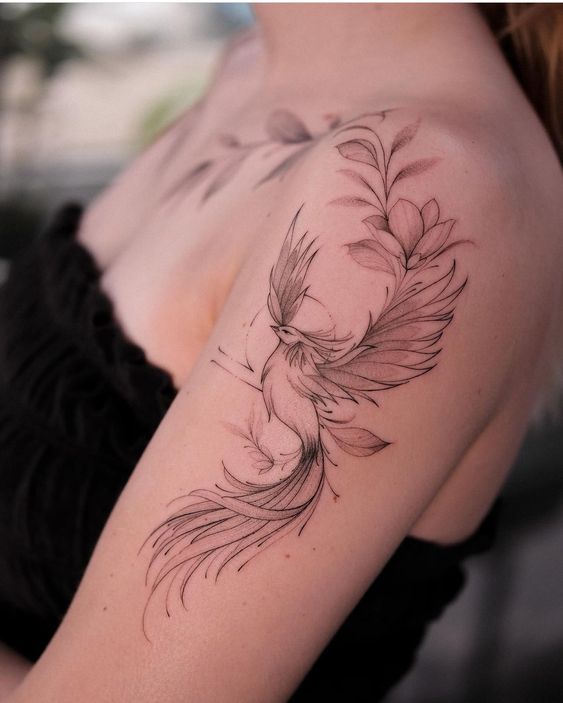
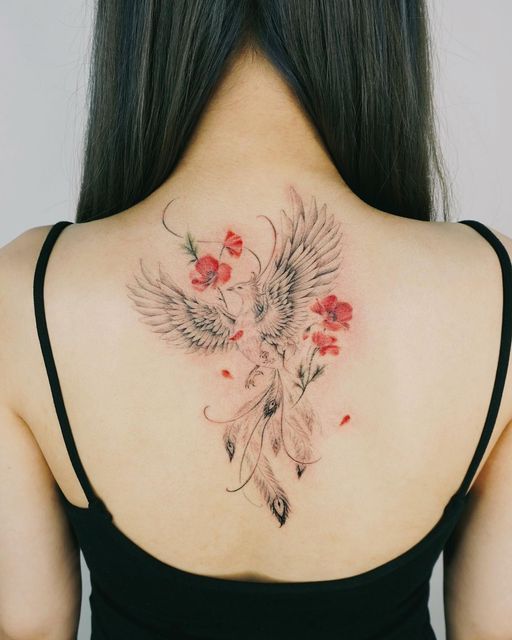
Phoenix tattoos with floral elements combine the mythical bird with beautiful flowers. This design merges rebirth and nature themes. Artists often use roses, lotus flowers, or cherry blossoms in these tattoos.
The phoenix can be shown rising from a bed of flowers. Or, floral patterns might decorate its wings and tail feathers. Some designs have flowers growing from the phoenix’s body or flames.
These tattoos can be colorful or black and gray. They work well as larger pieces on the back, chest, or thigh. Smaller versions can fit on arms or ankles too.
The mix of fire and flowers creates an eye-catching contrast. It represents the balance between destruction and growth. This tattoo style appeals to people who want a softer take on the fierce phoenix image.
Floral phoenix designs can be adapted to many tattoo styles. They look great in watercolor, traditional, or realistic styles. The combination allows for creative and unique interpretations of the phoenix myth.
10) Phoenix Embracing Sun
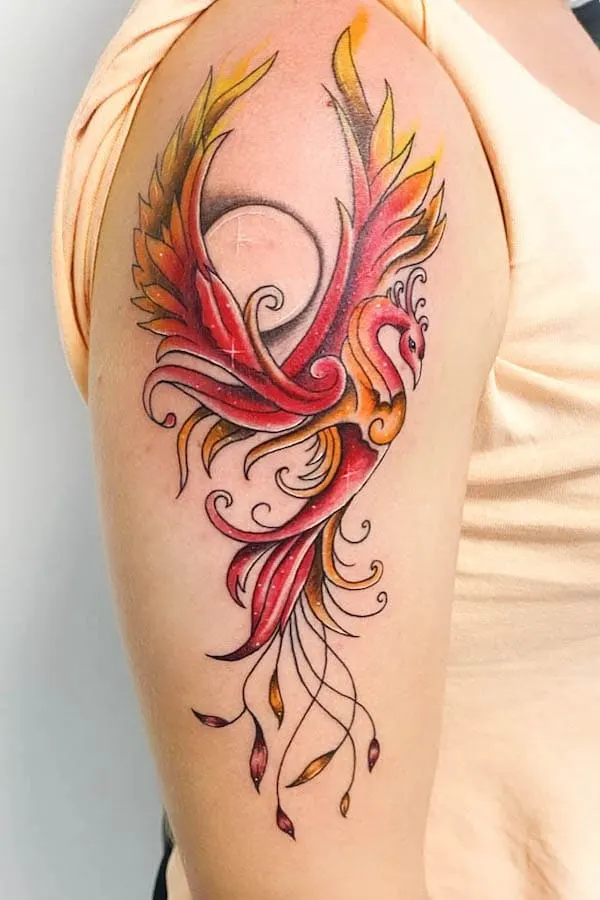
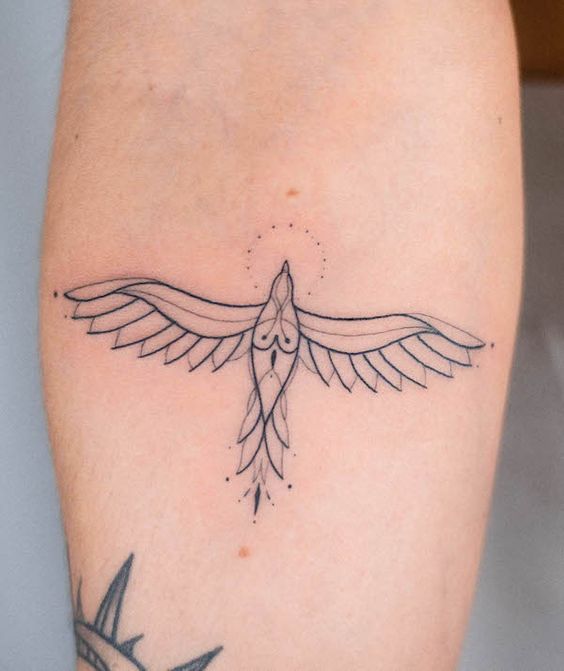
The Phoenix Embracing Sun tattoo design shows a phoenix bird with its wings spread wide around a glowing sun. This image combines two powerful symbols of rebirth and light.
The phoenix wraps its feathers protectively around the sun. Its fiery plumage blends with the sun’s rays. The bird seems to draw strength from the sun’s energy.
This tattoo represents hope, renewal, and inner power. It can remind the wearer that light always follows darkness. The phoenix rising with the sun shows triumph over challenges.
Some artists add swirling flames or sparkles to enhance the magical feel. Others use bold colors like red, orange, and gold to make the design pop. Simpler black and gray versions can also look striking.
This tattoo works well on the back, chest, or upper arm. Larger sizes allow for more intricate feather and sunbeam details. Smaller versions can focus on the key elements of the bird and sun.
Not sure what design fits you? Here’s how to find tattoo inspiration.
Symbolism and Meaning of Phoenix Tattoos
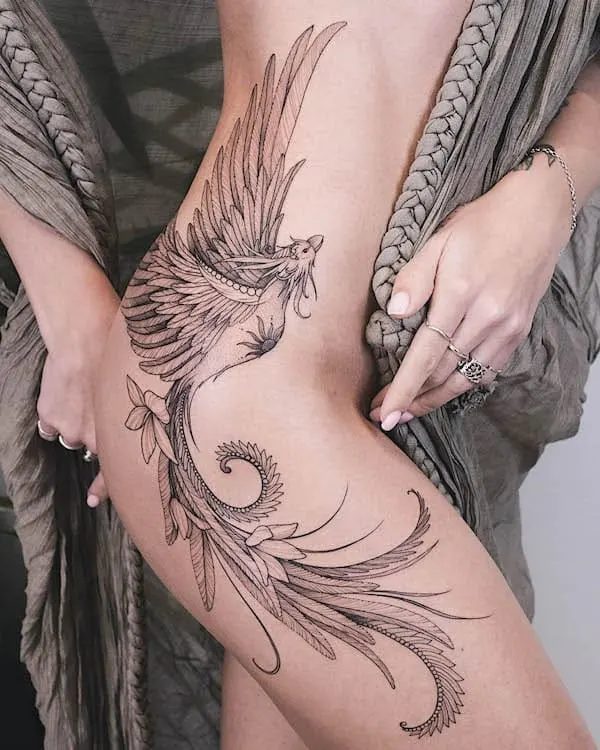
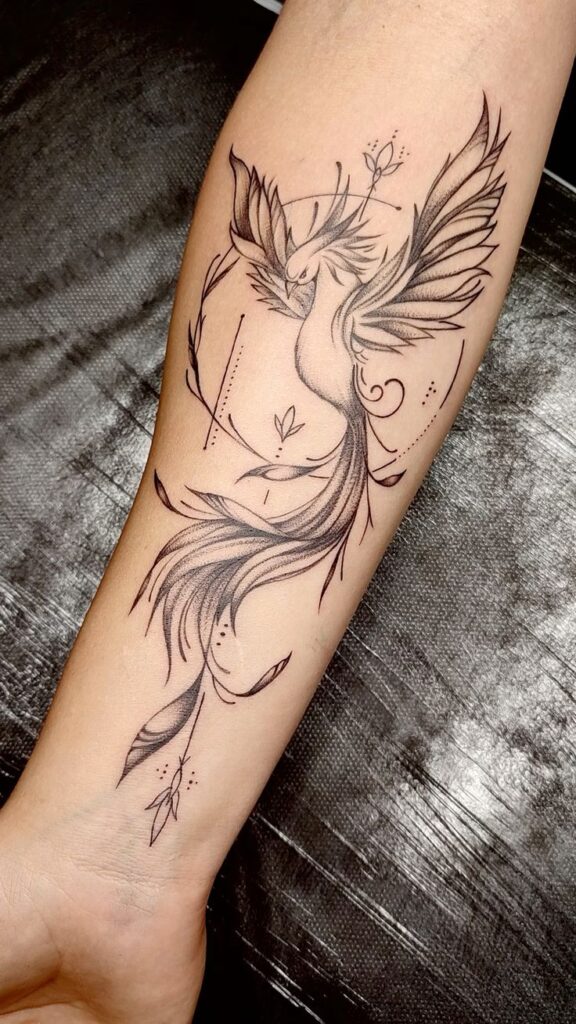
Phoenix tattoos carry deep symbolism tied to rebirth and transformation. The mythical bird has inspired people across cultures for centuries.
Cultural Significance
The phoenix appears in many ancient myths. In Greek lore, it rises from its own ashes every 500 years. Egyptian culture saw the phoenix as a symbol of the sun god Ra. Chinese folklore tells of the fenghuang, a phoenix-like creature representing virtue and grace.
In some Native American tribes, the thunderbird shares traits with the phoenix. It controls thunder and lightning. The thunderbird symbolizes power and strength.
Phoenix imagery shows up in religious texts too. Early Christians used it to represent Christ’s resurrection. In Judaism, the phoenix stands for faithfulness and redemption.
Modern Interpretations
Today, people get phoenix tattoos for personal reasons. Many see it as a sign of overcoming hardship. The bird’s rebirth represents a fresh start or new chapter in life.
Some view the phoenix as a symbol of inner strength. Its ability to rise from ashes shows resilience. This can inspire those facing tough times.
Phoenix tattoos can also represent:
- Survival
- Hope
- Transformation
- Spiritual awakening
The design often includes flames or ashes. This highlights the cycle of death and rebirth. Color choices can add meaning too. Red phoenixes may symbolize passion, while blue ones could represent calm and healing.
Design Elements of Phoenix Tattoos
Phoenix tattoos have key design features that make them stand out. These include color choices and stylization techniques that bring the mythical bird to life on skin.
Color Choices
Phoenix tattoos often use bold, fiery colors. Red, orange, and yellow are popular picks to show flames. Artists may add blues and purples for contrast. Some opt for all-black designs for a sleek look. Others use watercolor techniques for a softer effect.
Color can change the tattoo’s mood. Bright hues make it pop and grab attention. Muted tones create a more subtle image. The skin tone of the wearer also affects color choice. Darker skin may need brighter colors to show up well.
Stylization Techniques
Artists use different styles to create unique phoenix tattoos. Realistic designs aim to look like a real bird. They have detailed feathers and lifelike eyes. Abstract styles use simple shapes and lines. These can make the tattoo more symbolic.
Geometric patterns are trendy for modern looks. They break the phoenix into angular shapes. Traditional styles draw from old-school tattoo art. They have bold lines and limited colors. Some artists mix styles for a fresh take.
Size and placement affect stylization too. Large tattoos on backs or chests allow for more detail. Smaller designs on wrists or ankles need simpler lines. The tattoo’s style should fit its size and location on the body.
Choosing the Right Placement
The placement of a phoenix tattoo can impact its visual impact and personal meaning. Different areas of the body offer unique canvases for this powerful design.
Popular Placement Areas
Arms are a top choice for phoenix tattoos. The upper arm provides space for detailed wings and flames. Forearms allow for long, flowing designs that wrap around.
Back pieces offer a large canvas for intricate phoenix designs. Full back tattoos can showcase the bird’s rebirth in stunning detail.
Chest tattoos symbolize the heart and spirit. A phoenix over the heart represents resilience and inner strength.
Thighs and calves work well for vertical designs. These areas can accommodate both small and large phoenix tattoos.
Considerations for Different Body Parts
Pain levels vary by body part. Bony areas like ribs, spine, and feet tend to be more sensitive. Fleshier spots like upper arms and thighs usually hurt less.
Visibility is key. Neck and hand tattoos are always on display. Hidden placements like hips or upper back offer more privacy.
Body curves affect how the tattoo looks. A phoenix on the ribcage may stretch or compress as you move. Flat areas like shoulder blades keep the design intact.
Aging and weight changes can alter tattoos. Areas prone to stretching, like stomachs or upper arms, may distort over time. Consider how the placement will age.
Frequently Asked Questions
Phoenix tattoos have many design options and meanings. They can work for different genders and body placements.
How can I incorporate a phoenix into a tattoo design for men?
Men often choose bold phoenix designs. Large back or chest pieces are popular. Tribal styles with strong lines can create a masculine look. Some men opt for geometric shapes in their phoenix tattoo.
What are some delicate phoenix tattoo designs for women?
Women may prefer smaller, more delicate phoenix tattoos. Watercolor styles add a soft, artistic touch. Minimalist outlines can be very feminine. Placement on the wrist, ankle, or behind the ear works well for dainty designs.
What meanings are associated with a phoenix tattoo?
A phoenix tattoo often stands for rebirth and renewal. It can show strength and overcoming hard times. Some see it as a symbol of hope or transformation. The phoenix also links to fire and the sun in many cultures.
Can anyone get a phoenix tattoo, or does it have cultural restrictions?
Phoenix tattoos don’t have strict cultural limits. They appear in myths from many parts of the world. Still, it’s good to learn about the symbol’s history. This helps show respect for its cultural roots.
What are the considerations for placing a phoenix tattoo on the body?
Size matters when picking a spot for a phoenix tattoo. Large designs fit well on the back, chest, or thigh. Smaller ones can go on arms, ankles, or behind the ear. Think about how the tattoo will look as your body changes over time.
Does a phoenix tattoo signify rebirth across different cultures?
The phoenix often means rebirth in many cultures. In ancient Egypt, it was tied to the sun and renewal. Greek myths saw it as a symbol of revival. Chinese folklore links the phoenix to new beginnings. The basic idea of rebirth stays the same in most cultural views.
- 1.6Kshares
- Facebook0
- Pinterest1.6K
- Twitter0
